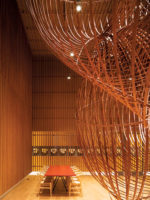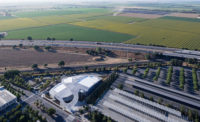Lightspeed Office by ACDF* Architecture
Montreal

Original walls within the 119-year-old building are nearly 2 feet thick. Some areas are roughly patched with concrete, contrasting with the polished terrazzo floors, also original to the building.
Photo © Adrien Williams

Glossy white floors, walls, and ceilings define much of the office.
Photo © Adrien Williams

Sunny yellows and pale blues mark work zones for specific teams.
Photo © Adrien Williams

The company logo is discreetly integrated into a wall at the office entrance.
Photo © Adrien Williams

The subtle color palette of the new insertions is juxtaposed with the existing brick.
Photo © Adrien Williams

The subtle color palette of the new insertions is juxtaposed with the existing brick.
Photo © Adrien Williams

The long kitchen and dining area doubles as a gathering space.
Photo © Adrien Williams

The arched window openings of the building’s limestone base, once exterior, now make up part of the interior.
Photo © Adrien Williams

Image courtesy ACDF









Architects & Firms
Just a few short years ago, Lightspeed was a scrappy start-up with offices inside a Montreal townhouse. When it came time to look for bigger digs, the company enlisted Montreal-based architects ACDF* to help find a new location and transform it into the perfect space for the growing business. The founders of the point-of-sale and e-commerce software provider—whose employees tend to be on the younger side—had one requirement: the new offices needed to have a pool.
That proved almost impossible to pull off, but by the time the team came upon the abandoned Viger Train Station and Hotel by the old port of Montreal, an immense, turreted, château-style structure that had been abandoned for over a decade and recently slated for redevelopment, they happily settled on a “castle” in lieu of a pool.
Additional Content:
Jump to credits & specifications
ACDF* initially renovated the upper floors of the building for the company’s move in 2015. The design strategy was simple—leave as much as possible of the existing structure exposed. “They wanted it to feel as if they were squatters inside the castle,” says ACDF* founder Maxime- Alexis Frappier. Though now landmarked, the condition of the 1898 building was much deteriorated after being gutted and neglected. Its bones, however, were impeccable. Large timber rafters, 20-inch-thick red-brick shear walls, and polished terrazzo floors define the office, which is punctuated by long rows of desks.
But what do you do when a start-up grows up? As the company blossomed into a global one—it now has offices in London, Amsterdam, and New York, among other cities—even more space was required, so it expanded onto the ground floor, in the area once occupied by the former train station. The basic strategy for these offices—destined for its nearly 100 product developers—was the same, but, this time around, ACDF* added some flourishes that give the space an air of sophistication while still working with a very modest budget.
Most noticeably, an alluring palette of sunny yellows, pale pinks, and soft blues extends in diagonals from the floor to the walls to mark work zones and breakout rooms for specific teams. Smaller rooms that serve as phone booths or areas for one or two people to work are painted a deep red.
Overall, the 11,200-square-foot open office space features a glossy white epoxy-coated floor interspersed with the original terrazzo. Enclosed conference rooms are carpeted. At the entrance, microperforated vinyl in various shades of gray and black, sandwiched between two layers of epoxy, extends up a wall as a quiet backdrop for the company logo.
And unlike the way it is upstairs, where ceiling ducts and pipes are exposed, a white gypsum ceiling conceals most of the HVAC in the 15-foot-high, daylight-filled ground-floor space. (LEDs provide all electric lighting, mainly simple spots integrated into the ceiling as well as desk lamps.) Throughout the space, crisp, rectilinear geometries juxtapose with the jagged remnants—cut-through walls and broken-off pilasters—of the original structure, and the rough concrete patchwork that was applied over parts of it.
Some areas of the 119-year-old building, however, remain perfectly intact. Extending through to the inside, the limestone base surrounding the arched windows, for instance, add refinement. In the back of the structure, where the building opened up to the railway tracks, what once was an exterior wall, also limestone, now defines the kitchen and lounge, a corridor-like space set off by a long, black dining table and black ceilings that obscure the ductwork overhead. The alley, as it has come to be known, serves as a relaxed break room, with smaller tables and lounge seating, or as an all-company gathering space that can accommodate up to 300 people.
The product developers moved in this spring, occupying nearly all the seats at the long white desks and adding their notes and doodles on the walls-cum-whiteboards. The fast-paced nature of a start-up means that the office has very quickly achieved a lived-in feel—one that nicely mediates the contrast between the glossy new construction and the beautiful decay.
CreditsArchitect: ACDF Architecture — Maxime-Alexis Frappier, partner in charge
Engineer: Stantec (mechanical and electrical)
General contractor: Anjinnov
|
SpecificationsPlastic Laminate Formica, Abet Laminati, Fenix NTM
Glass doors C.R. Laurence
Hardware Rockwood, Sargent, Stanpro
Vinyl wallcoverings Groupe Lettra
Paints and stains Sico Paints
Furniture Haworth, Herman Miller, Softline, Pedrali, Trica
Lighting Litéline, ConTech |
















